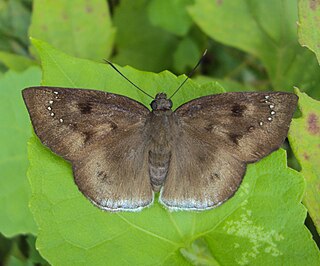
Hasora badra, the common awl, is a butterfly belonging to the family Hesperiidae, which is found in India.

Halpe homolea, the Indian ace or Ceylon ace, is a butterfly belonging to the family Hesperiidae.

Halpe porus, commonly known as Moore's ace, is a species of butterfly in the family Hesperiidae, found in India.

Iambrix salsala, the chestnut bob, is a butterfly belonging to the family Hesperiidae, that is found in parts of South Asia and Southeast Asia.

Thoressa astigmata, the southern spotted ace, is a butterfly belonging to the family Hesperiidae. The species was first described by Charles Swinhoe in 1890. It is endemic to the Western Ghats of India and is found in the states of Kerala, Tamil Nadu and Karnataka.

Abaratha ransonnetii, commonly known as the golden angle, is a butterfly belonging to the family Hesperiidae. It was first described by Baron Cajetan von Felder in 1868.

Gomalia elma, also known as the marbled skipper or African marbled skipper, is a species of hesperiid butterfly. It is found in Africa and parts of Asia.

Odontoptilum angulata, the chestnut angle or banded angle, is a butterfly belonging to the family Hesperiidae and is found in India and southeast Asia.

Spialia galba, the Indian grizzled skipper, is a hesperiid butterfly which is found in South Asia and parts of Southeast Asia.

Tagiades gana, the immaculate snow flat, large snow flat or suffused snow flat, is a butterfly belonging to the family Hesperiidae found in Indomalayan realm.

Hyarotis adrastus, the tree flitter, is a butterfly belonging to the family Hesperiidae found in South Asia and Southeast Asia.

Nacaduba pavana, the small four-line blue or Singapore four-line blue, is a species of lycaenid butterfly found in Southeast Asia.

Nacaduba berenice, the rounded six-line blue, is a lycaenid butterfly found in Indomalayan realm. The species was first described by Gottlieb August Wilhelm Herrich-Schäffer in 1869.

Zizeeria karsandra, the dark grass blue, is a small butterfly first described by Frederic Moore in 1865. It is found from the southern Mediterranean, in a broad band to India, Sri Lanka, the Andaman and Nicobar islands, Myanmar, Thailand, Malaysia, Yunnan, Indonesia, the Philippines, Arabia, United Arab Emirates, Saudi Arabia and Oman, New Guinea and northern and eastern Australia. It belongs to the lycaenids or blues family, and the tribe Polyommatini.

Euchromius ocellea, the necklace veneer or belted grass-veneer, is a cosmopolitan migratory species of moth of the family Crambidae, first described by Adrian Hardy Haworth in 1811. It has Hodges number 5454.

Charaxes brutus, the white-barred emperor or white-barred Charaxes, is a butterfly of the family Nymphalidae. It is found in Africa.

Spilosoma batesi is a moth of the family Erebidae. It was described by Walter Rothschild in 1910. It is found in Nigeria, Cameroon, Congo and Zaire.

Lophocampa andensis is a moth in the family Erebidae. It was described by Schaus in 1896. It is found in Colombia.

Episcepsis venata is a moth of the family Erebidae. It was described by Arthur Gardiner Butler in 1877. It is found in Mexico and the Amazon region.

Grapholita lunulana is a moth belonging to the family Tortricidae. The species was first described by Michael Denis and Ignaz Schiffermüller in 1775.


















